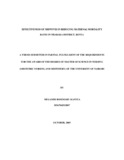| dc.contributor.author | Mugambi, Rosemary K | |
| dc.date.accessioned | 2013-05-24T08:40:47Z | |
| dc.date.available | 2013-05-24T08:40:47Z | |
| dc.date.issued | 2009 | |
| dc.identifier.citation | Master of science in nursing (obstetric nursing and midwifery) | en |
| dc.identifier.uri | http://erepository.uonbi.ac.ke:8080/xmlui/handle/123456789/25251 | |
| dc.description.abstract | Introduction: Midwives have the ability to effectively reduce maternal mortality using
competencies and proficiency in midwifery skills. The purpose of this study was to
investigate effectiveness of midwives in reducing maternal mortality in order to give insight
into the current practices in obstetric care in Tharaka District, Kenya.
Study Objective: This study was to determine the effectiveness of midwives in reducing
maternal mortality in Tharaka District. The study focused on quality of care practices,
knowledge, institutional and patient characteristics as well as midwives' attitude.
Methodology: A cross-sectional descriptive study was carried out in the public and faith
based health facilities that provide maternity services in Tharaka District. Facilities were
selected by multistage sampling. Purposive sampling of the midwives (N= 48) was done.
Ethical clearance was obtained from the Kenyatta National Hospital Standards and Ethics
Committee, the Ministry of Education Science and Technology, and the District Medical
Officer of health Tharaka. Midwives gave a written consent to participate in the study. A
structured self-administered questionnaire was used. Quantitative data was analyzed using
SPSS version 16. Descriptive statistics and Chi square were used to bring out relationships
~between study variables. Eight Key Informants were interviewed to obtain in-depth
information. Content analysis was done for qualitative data.
Results: Few midwives 4(9.1%) listed the correct components of a partograph. There is no
positive correlation between respondents experience and competence in plotting a partograph
(p value = 0.229). Midwives are not well prepared in handling critical obstetric activities like
severe preeclampsia 9 (20.5%), eclampsia 9 (20.5%). Poor transport, lack of referral facilities
and low economic status of patients contributed to delay in accessing care.
Conclusions: The results revealed moderate performance rating in knowledge and clinical
competencies among midwives in Tharaka District. Midwives indicated need for coaching in
very critical skills that have an immediate impact on maternal outcome.
Recommendations: There is need to carry out an observational study to evaluate the specific
midwifery skills that have a direct influence on maternal mortality in Tharaka District. These
will reveal the gaps in midwives' competencies that require updating in order to enhance
effectiveness. | en |
| dc.description.sponsorship | University of Nairobi | en |
| dc.language.iso | en | en |
| dc.title | Effectiveness of midwives in reducing maternal mortality rates in Tharaka district, Kenya | en |
| dc.type | Thesis | en |
| dc.description.department | a
Department of Psychiatry, University of Nairobi, ; bDepartment of Mental Health, School of Medicine,
Moi University, Eldoret, Kenya | |

